40 years of Microsoft Flight Simulator: Asobo celebrates the success story with a special aircraft
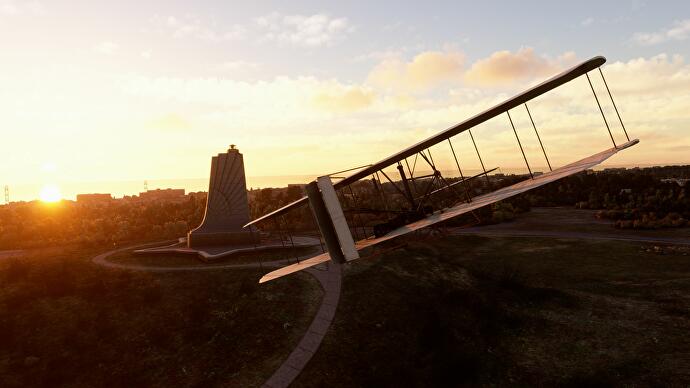
On the west coast of the USA between fields and vineyards there was a big party in honor of Microsoft Flight Simulator. The popular franchise is exactly 40 years old to the month, player numbers are increasing and things couldn’t get any better. The team has therefore chosen a very special location for the celebrations and the presentation of the new update. McMinnville is the name of the small town in the state of Oregon that I ended up in at the beginning of November.
Why a small town with less than 35,000 inhabitants? Asobo himself is based in Bordeaux in France – a beautiful city that would have been just as good, right? No, not quite, because it was the only way the studio could hold its event at the Evergreen Aviation & Space Museum, which is very related to the new content. I invested thirteen hours and two flights for a tour and was rewarded with a wonderful event, a detailed presentation of the 40th Anniversary Edition, numerous interviews and an extensive hands-on session.

Microsoft Flight Simulator takes off despite its age
Flight Simulator is one of Microsoft’s most successful franchises. It’s been around longer than Microsoft Office and I was far from planning it when the first flight sim part saw the light of day in 1982. Several generations of players have already boarded the virtual plane and made their rounds. Pilots who can’t get enough of the dizzy heights when they’re not on the job, and couch potatoes who can explore the most remote places with little effort and money.
40 years. Service games dream of such a life expectancy at night. And so far it looks like Microsoft Flight Simulator is still a long way from descending. Especially the release on the Xbox has given the latest version a good boost. In the one-hour presentation in a cinema hall at the museum, Asobo’s project manager Jörg Neumann explained that the number of players had doubled since the release on the console and later on Xbox Everywhere. The pandemic also made many new hobby pilots get on the plane in order to at least travel virtually or return home.
A question that had been on my mind even before the event was how a flight simulator could stay on the wings for so long. According to Neumann, realism, vision of the game, real-time relevance and innovation are the four pillars of success. Technically, the simulator was almost always at the best possible level and Asobo always had an open ear for all parts of its community when making decisions – regardless of whether it was a beginner or a high-flyer. That’s exactly what Asobo did for the 40th anniversary of the simulator and fulfilled two of the players’ big wishes, along with a lot of other content.
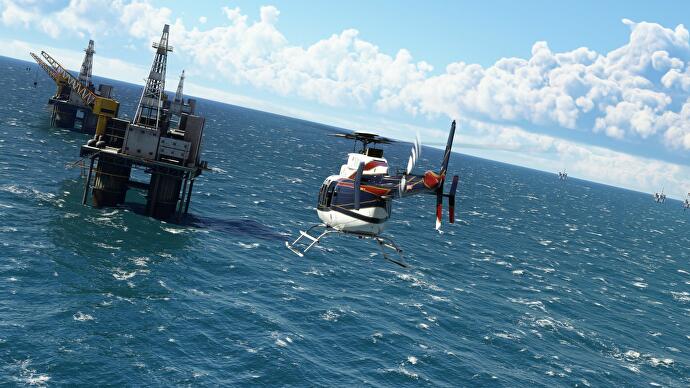
40th Anniversary Edition – This is waiting behind the blue wrapping paper
Included on board the free 40th Anniversary Edition are four new airports, 24 classic missions from older versions, seven historic aircraft, the Airbus 310, two helicopters and 14 helipads, two gliders and 15 matching landing pads. The two new types of aircraft in particular should quickly catch the eye of connoisseurs and have often been in demand in the community. These two new means of transport were the focus of the hands-on session. For this purpose, Asobo has set up a huge station with Xbox consoles, the finest screens and the full range of hardware equipment from various suppliers right in the Evergreen Museum.
Under the best conditions, I first grabbed the helicopter and tried to fly it in the air and then around the pudding. The display for the airflow is particularly impressive. The green lines show exactly how the air circulates around the helicopter and can easily keep up with professional software. The team recommended that I use a gamepad or a joystick to control the helicopter and use the two new flight aids. That was also necessary, because the controls are not that easy and intuitive when you are used to the airplanes. However, there are no training missions for the helicopter. “Learning by doing” is the premise here, which Asobo also stands behind. A few useful tips are at least displayed at the top right of the screen. But once you get the hang of the controls, the helicopters bring a whole new perspective to the flight simulator, allowing you to fly much closer to objects and lower to the ground.
The glider pilots, on the other hand, are much more relaxed. Completely without a motor drive, you are exposed to the air currents and slowly glide over the wide areas, see sunsets and simply enjoy the view. Since you cannot take off on your own, there are several options for getting you into the air, all of which are dealt with within the seven training sessions. For the first time you get support from an NPC, Jimmy, who ensures a smooth start. Being exposed to the forces of nature and not having an engine to keep you in the air a little longer and more constantly if necessary is an exciting feeling. A tool shows you where warm air currents escaped from the ground that let you rise. You shouldn’t take your hands off the controller with the gliders. Otherwise, the winds can throw you off balance and bang your nose on the ground like a poorly built paper airplane.
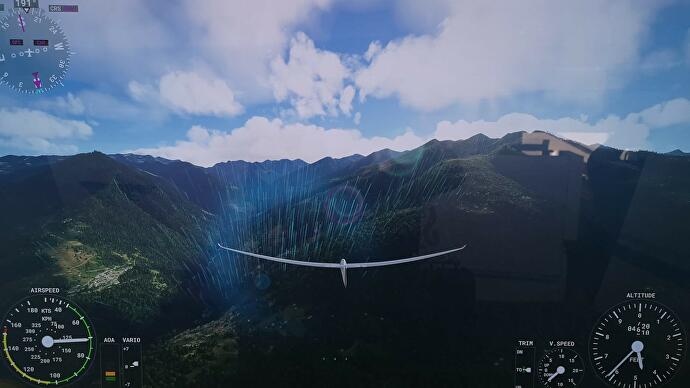
The update is a total of 40 GB and Jörg Neumann knows that the game will be much, much bigger. “When the Microsoft Flight Simulator came out it was about 120GB, now we’re at 300GB. I just made the plan for next year and we’re going to be over 500GB. At some point it might not be that easy anymore move on.” The storage space is becoming really inconveniently large, but at least it means a lot more content for all airplane lovers. And who knows what the clever minds in the field of storage technology will come up with by then.
Welcomes the guest of honor: The Spruce Goose is coming to Flight Simulator
The highlight of the event and the biggest selling point for the venue was the Spruce Goose, the largest wooden airplane ever built. This will be brought into play with the 40th Anniversary Edition and could be admired in all its glory by all participants of the event. This is the original, not a replica. With a wingspan of 97.5 meters, a length of 66 meters and a weight of 136,000 kilograms – when it is completely empty, mind you – the living piece of aircraft history filled the entire exhibition space and, with the best will in the world, did not fit in a normal photo. Maybe one with a panorama function?
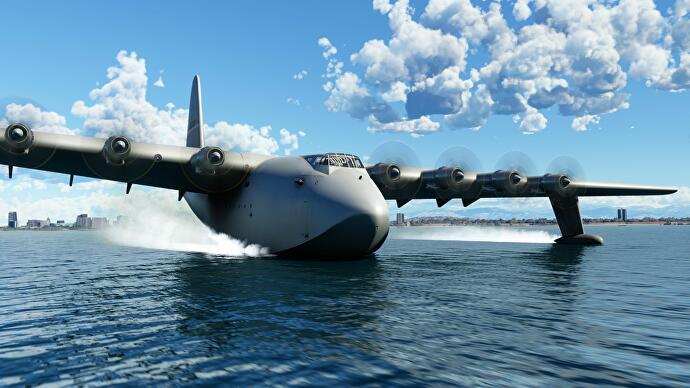
What makes the Spruce Goose unique is not its flight career. In 1947, the wooden monster was in the air for a whopping 30 seconds at a height of 25 meters. After that she took early retirement. The gray painted wooden plane is the only one of its kind and consists mostly of birch and is particularly stable thanks to the glue and the special gluing technique. Spruce, or “spruce” as it is called in English, makes up only one percent of the wood’s body. Only the motor with 3,000 hp, screws, electronics and a few other fasteners are not made of wood. I was able to compare the cockpit, which I was allowed to get a taste of, with the model in the flight simulator later on. There it flies very leisurely and is difficult to steer due to its weight and size. If you are in the air, you can actually make yourself a coffee quickly. A really interesting plane, even for those who wouldn’t consider themselves a hardcore flight nerd.
The Flight Sim team was allowed to measure this unique aircraft in the museum and was also provided with all sorts of data from the museum so that the heavy chunk could be reproduced as realistically as possible in the Microsoft Flight Simulator. But how did the collaboration between Asobo and the Evergreen Museum actually come about? It all started with a spontaneous call from an employee, says museum CEO Tyson Weinert. He called Asobos Jörg Neumann and got straight to the point: “What do you think of the Spruce Goose?” Since we know how the story ended, Neumann must have liked the idea very much. They had previously had no contact with Neumann. However, the Evergreen Museum can certainly be associated with video games, because in addition to general curiosity about this topic, there were also old flight sim labs in the halls of the historic aircraft paradise. The museum is more than open to future projects or at least maintaining this good partnership.
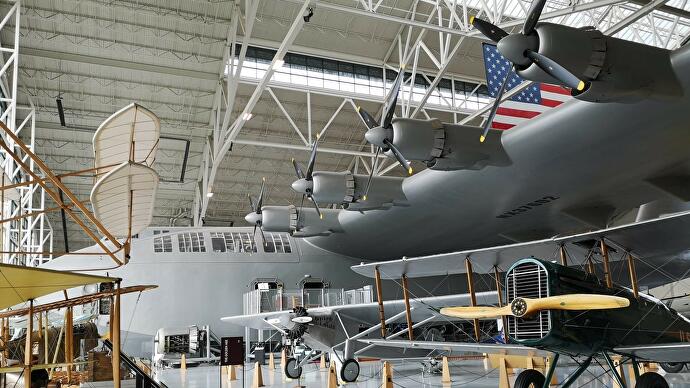
After a long day filled with interesting conversations, a tour of the museum, delicious food and a few sips of local wine enjoyed under the mighty wings of the Spruce Goose, it was time to get on the plane again. In contrast to the Flight Simulator, I preferred to start the long way home as a passenger.
![]()
Reference-www.eurogamer.de